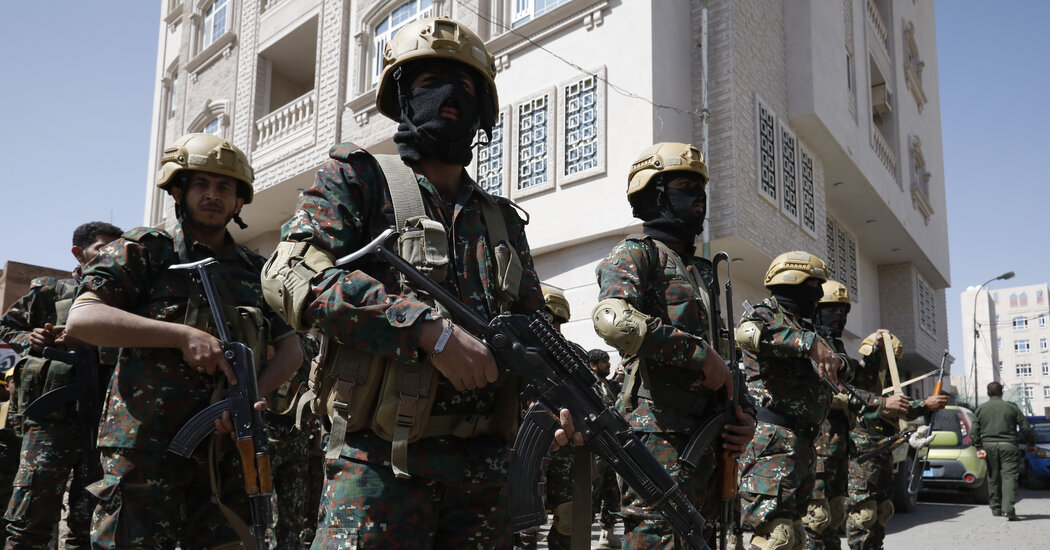
BEIRUT, Lebanon — When a band of scrappy rebels known as the Houthis stormed out of the mountains of northern Yemen in 2014 and took over the capital, Sana, their friends and foes alike dismissed them as unsophisticated tribal fighters running around in sandals and armed with cheap guns.
But during the civil war that has shattered Yemen in the years since, the group has gone through a remarkable transformation. It now rules a repressive proto-state in northern Yemen and wields a vast arsenal that includes an array of cruise and ballistic missiles and kamikaze boats.
The Houthis also assemble their own long-range drones, which have extended their reach across the Arabian Peninsula and amplified threats to the Persian Gulf powerhouses Saudi Arabia and the United Arab Emirates, both partners of the United States and leaders of the coalition that has waged war against the Houthis since 2015.
The swift expansion of the Houthis’ abilities is largely thanks to covert military aid from Iran, according to American and Middle Eastern officials and analysts.
Seeking new ways to menace Saudi Arabia, its regional nemesis, Iran has integrated the Houthis into its network of militias and built up the Houthis’ ability to subvert their wealthy neighbors’ defenses with relatively cheap weapons. And many of those weapons are now built in Yemen, the Arab world’s poorest country.
“What we are seeing in Yemen is technology being the great equalizer,” said Abdulghani Al-Iryani, a senior researcher at the Sana’a Center for Strategic Studies. Summarizing the Houthi mind-set, he said, “Your F-15 that costs millions of dollars means nothing because I have my drone that cost a few thousand dollars that will do just as much damage.”
The rise of the Houthis as a force capable of striking far beyond Yemen’s borders has helped drive a broader political realignment taking hold in the Middle East, which led a few Arab countries to establish diplomatic relations with Israel in 2020 and others to move toward covert military and intelligence cooperation to counter Iran.
Saudi Arabia and the U.A.E. share Israel’s alarm at Iran’s military support for militias across the region and look to Israel as a possible new defense partner, hoping that techniques it has developed to defend itself against Hamas in Gaza and Hezbollah in Lebanon — both also clients of Iran — could protect them, too.
The Houthis’ advancing military technology has added new urgency to Saudi efforts to end the war seven years after intervening. But those advances may also have made the Houthis less interested in ending it, even though they agreed to a two-month cease-fire that began at the start of this month, aimed at kick-starting peace talks. Saudi Arabia and the U.A.E. have also thrown their support behind a new presidential council formed this month to run the Yemeni government and lead negotiations with the Houthis.
Still, in the first three months of this year, the Houthis demonstrated the threat they posed to Persian Gulf countries.
Attacks launched from Yemen killed three workers at a fuel depot in Abu Dhabi, the capital of the U.A.E.; put American troops in the U.A.E. on alert while U.S. and Emirati forces deployed costly defense systems to shoot down incoming missiles; and ignited an oil facility in western Saudi Arabia, filling the sky over a Formula One car race with thick black smoke.
The war has deepened the Houthis’ relationship with their powerful backer, Iran, allowing them to develop a vast war economy to fund their operations. It has also made them the uncontested authority over a large section of northern Yemen, where more than two-thirds of the country’s population lives — gains they are unlikely to give up voluntarily, analysts said.
“If the war stops, the Houthis will have to govern, and they don’t want to govern — to provide services and share power,” said Nadwa Al-Dawsari, a Yemen analyst at the Middle East Institute. “The Houthis thrive in war, not peace.”
The Houthis, officially known as Ansar Allah, or the Partisans of God, honed their guerrilla abilities during a series of brutal battles with the Yemeni state and Saudi Arabia in the 2000s. Those conflicts bolstered their sense of themselves as underdogs defending Yemen from more powerful aggressors.
Their slogan — “Death to America. Death to Israel. Curse on the Jews. Victory for Islam.” — is splashed on posters across their territory and screamed at protests.
In 2014, the Houthis seized Sana, proclaiming that they sought to stamp out corruption. A Saudi-led military coalition intervened against them in early 2015, launching a bombing campaign aimed at restoring the internationally recognized government that the Houthis had driven into exile.
As the war settled into a grinding stalemate and festering humanitarian crisis, Iran quietly ramped up its support for the Houthi war machine.
Houthi technicians flew to Iran for training, and experts from Iran’s Islamic Revolutionary Guards Corps and Lebanon’s Hezbollah traveled to Yemen to organize the group’s fighters and media teams and, later, to teach Houthi technicians how to build weapons, according to members of the Iranian axis in the region and analysts tracking the conflict.
Early in the war, the Houthis mostly hit back at Saudi Arabia by striking targets along the Saudi border with northern Yemen. But the reach and sophistication of their weapons have increased rapidly, enabling them to accurately target sensitive sites in Saudi Arabia and the U.A.E., many hundreds of miles from Yemen’s borders.
Their weapons now include cruise and ballistic missiles, some of which can fly more than 700 miles, according to a recent report on the Houthis by Katherine Zimmerman, a fellow at the American Enterprise Institute. They have deployed pilotless kamikaze boats to strike ships in the Arabian Sea and have an array of drones that carry explosive charges and can fly as far as 1,300 miles.
Some equipment, like drone engines and GPS systems, are smuggled in with Iranian help, Ms. Zimmerman wrote. But most of the group’s weapons are made in Yemen. Drones are assembled from smuggled and local parts with Iranian technology and know-how, and missiles are built from scratch or modified to give them the range needed to reach deep inside Saudi Arabia.
So far, most Houthi attacks have caused limited damage and their foes have learned to shoot down incoming drones and missiles.
But before the cease-fire began, Saudi Arabia often faced multiple attacks per month. The Saudi-led coalition said in December that the Houthis had launched 430 ballistic missiles and 851 armed drones at the kingdom since March 2015, killing 59 Saudi civilians.
And defending against incoming fire is hugely expensive. A missile for a Patriot defense system, for example, could cost $1 million, Ms. Zimmerman said, while Houthi drones and missiles are estimated to cost $1,500 to $10,000.
Understand the War in Yemen
A divided country. A Saudi-led coalition has been fighting in Yemen against the Houthis, a Shiite Muslim rebel group that dominates in northern parts of the country, for years. Here’s what to know about the conflict:
In a speech last month marking the seventh anniversary of the Saudi-led intervention, the Houthi leader, Abdul-Malik al-Houthi, said the Saudi-led blockade of their territory and airstrikes on their bases and storehouses had pushed the group toward domestic weapons manufacturing. The group’s goal, he said, was to be able to strike any target, including in Saudi Arabia, the United Arab Emirates or the Arabian Sea.
“We have worked to reach the level of launching from anywhere we want, even to the sea,” Mr. al-Houthi said. “We are very keen on that, to strike from any governorate to any point in the sea.”
Iran’s cultivation of the Houthis mirrors how it has built up other militias over the past three decades to extend its reach across the Middle East, including Hezbollah in Lebanon, Hamas in Gaza and other fighting groups in Syria and Iraq.
This network, which calls itself the Axis of Resistance and also includes the Syrian government of President Bashar al-Assad, coordinates to fight Israeli and American influence in the region while giving Tehran a way to menace and strike its enemies, minimizing the risk of retaliation against Iran itself.
Iran’s relationship with the Houthis goes back to at least 2009, but it has used the war to integrate the Houthis into its proxy network.
That integration is so complete that at least twice the Houthis have claimed attacks that — for the most part — they were not responsible for, to provide cover for other Iran-backed groups.
In 2019, the Houthis claimed a drone and missile attack on oil facilities in eastern Saudi Arabia that temporarily halted half of the kingdom’s oil output. While Houthi drones were most likely part of the attack, the major damage was from cruise missiles that probably came from the north, perhaps fired from Iraq or Iran, United States officials later concluded.
The Houthis also initially claimed responsibility for an attack on the U.A.E. in February, although that too appeared to have been launched from Iraq and was later claimed by a shadowy militant group there.
In the territory they control, the Houthis have set up a repressive police state aimed at squashing any threat to their control and routing all resources to their war machine.
Their security forces have locked up journalists and ordinary citizens for criticizing the movement, and a report to the United Nations Security Council this year by the Panel of Experts on Yemen said the group regularly employed sexual violence against politically active and professional women.
The group funds itself through an elaborate war economy that includes levying arbitrary fees on businesses and the general population and diverting profits from the area’s oil and telecoms sectors. The panel wrote last year that the Houthis had steered at least $1.8 billion that was intended for the Yemeni government into its coffers in 2019.
The Houthis also recruit children to fight, and more than 2,000 were killed in combat from January 2020 to May 2021, the panel wrote this year.
Children not on the front lines are steeped in Houthi propaganda at government schools, where many families can no longer afford to send their children because of the country’s collapsing economy.
“They have launched a war on education, and that is not just indoctrination,” said Ms. Al-Dawsari of the Middle East Institute. “They are indoctrinating the children with their own sectarian beliefs, and they have made it very difficult for people to send their children to school.”
Hwaida Saad and Asmaa al-Omar contributed reporting.




